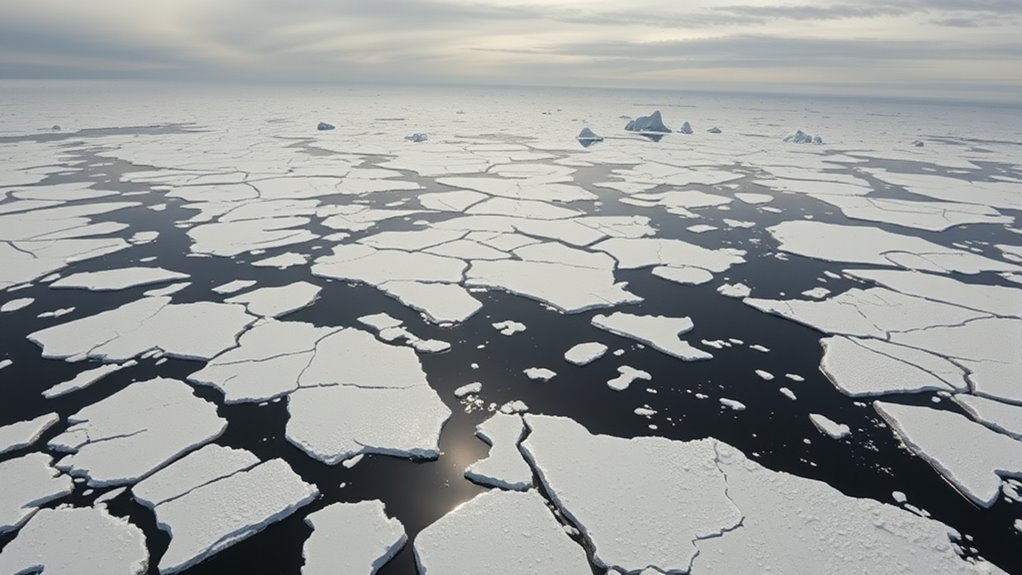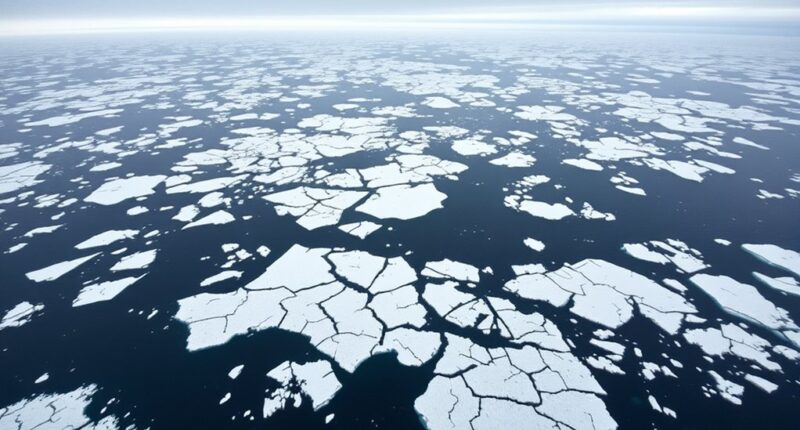You’ll notice that the Arctic just hit its lowest July sea ice extent on record, signaling rapid climate change. This sharp decline is driven by human activity, which accelerates melting and exposes more ocean, amplifying global warming. As ice diminishes, Ecosystem shifts and weather patterns get more unpredictable, affecting wildlife and worldwide climate. If you want to understand why this matters and what’s next, there’s more to learn about the impacts of Arctic ice loss.
Key Takeaways
- July’s Arctic sea ice extent reached a new record low, highlighting a significant long-term decline.
- The shrinking ice reflects ongoing climate change driven by human activities.
- Reduced ice coverage impacts polar ecosystems, threatening species like polar bears and seals.
- Arctic ice loss influences global weather patterns, increasing extreme weather events worldwide.
- The record low underscores the urgent need for climate action to prevent further environmental damage.

Recent measurements reveal that Arctic sea ice is shrinking at an alarming rate, setting new records for minimal extent. This rapid decline underscores the profound climate change impacts that are transforming one of Earth’s most sensitive regions. As the ice recedes, you can observe significant polar ecosystem shifts, affecting species that depend on the ice for survival. The shrinking ice cover not only signals a warming planet but also disrupts the delicate balance of Arctic life.
Arctic sea ice is rapidly shrinking, threatening ecosystems and signaling urgent climate change impacts.
You might notice that the loss of sea ice exposes more of the ocean surface, which absorbs more sunlight and accelerates global warming. This feedback loop intensifies climate change impacts, creating a cycle where melting ice leads to further warming and more ice loss. The current record for July’s minimum extent is a stark reminder of how quickly these changes are happening. It’s not just a seasonal fluctuation; it’s a clear trend pointing to long-term shifts driven by human activity.
As the ice diminishes, polar ecosystems face dramatic shifts. Iconic species like polar bears and seals struggle to find stable habitats, forcing them to adapt or relocate. The thinning ice impacts their hunting grounds, making it harder for them to find food. Meanwhile, the loss of sea ice affects migratory patterns and breeding grounds for various marine life, leading to a cascade of ecological consequences. This disruption extends beyond wildlife, impacting indigenous communities that rely on Arctic resources and traditional practices.
You should also be aware that the reduction in sea ice influences global weather patterns. The Arctic acts as a regulator for Earth’s climate, and its destabilization can lead to more extreme weather events elsewhere. Changes in atmospheric circulation patterns, driven by the loss of ice, can cause colder winters in some regions and hotter summers in others. The interconnectedness means that what happens in the Arctic doesn’t stay in the Arctic; it has worldwide implications.
In essence, the record low in July’s Arctic sea ice extent highlights the urgent need to address climate change impacts. The Arctic acts as a barometer for the planet’s health, and its rapid ice loss signals that action is critical. If current trends continue, polar ecosystem shifts will become even more severe, threatening biodiversity and human livelihoods alike. Recognizing these changes is essential for understanding the broader consequences of climate change and for taking steps to mitigate further damage. The Arctic’s shrinking ice isn’t just an isolated phenomenon; it’s a warning sign demanding immediate attention.
Frequently Asked Questions
How Does July Sea Ice Extent Compare to Historical Averages?
You notice that July sea ice extent is much lower than historical averages, which impacts polar bears and the ice albedo effect. Less ice means fewer habitats for polar bears, risking their survival. It also lowers the ice albedo, causing more sunlight absorption and accelerating warming. This decline highlights the urgent need to address climate change, as ongoing melting threatens ecosystems and global climate stability.
What Are the Potential Global Climate Impacts of Reduced Arctic Ice?
Imagine the Arctic as Earth’s mirror, reflecting climate health. When ice melts, it triggers climate feedbacks that accelerate warming worldwide. Reduced Arctic ice can raise global sea levels, threatening coastal communities and ecosystems. As the ice diminishes, the planet’s balance shifts, amplifying climate instability. You should recognize that the loss of Arctic ice isn’t just a regional issue; it’s a signal of broader, urgent changes affecting global climate stability.
How Are Scientists Predicting Future Arctic Sea Ice Trends?
Scientists predict future Arctic sea ice trends through climate modeling, which simulates how ice melt responds to rising global temperatures. You can expect models to project continued decline in ice extent, especially during summer months, due to ongoing climate change. These models incorporate variables like greenhouse gas emissions and natural variability, helping you understand potential future scenarios and the urgency of reducing emissions to slow ice loss.
What Role Do Ocean Currents Play in Arctic Ice Loss?
Imagine ocean currents as the Earth’s circulatory system, moving heat and cold across the globe. You should know that ocean circulation greatly influences ice melt dynamics in the Arctic. Warm currents, like the Gulf Stream, bring heat that accelerates ice loss, while cold currents help preserve ice. As these currents shift due to climate change, they play a vital role in speeding up or slowing down Arctic sea ice loss.
How Might Arctic Ice Decline Affect Indigenous Communities?
You might find that the decline in Arctic ice threatens indigenous livelihoods, as traditional hunting and fishing rely on stable ice conditions. This loss hampers their ability to access hunting grounds and preserves their cultural practices. As ice diminishes, your community could face increased hardships, making it harder to maintain cultural preservation. The changing environment demands adaptation, but it also risks eroding the unique heritage that defines indigenous peoples in the Arctic.
Conclusion
As you witness this historic low, remember the Arctic’s cry echoes like a warning bell, calling you to heed nature’s fragile balance. Just as Icarus soared too close to the sun, our relentless pursuit of progress risks melting away the icy fortress that once protected our planet. If you ignore these signs, the Arctic’s silent tears may become the storm that reshapes our world, reminding you that every action today shapes tomorrow’s climate landscape.









